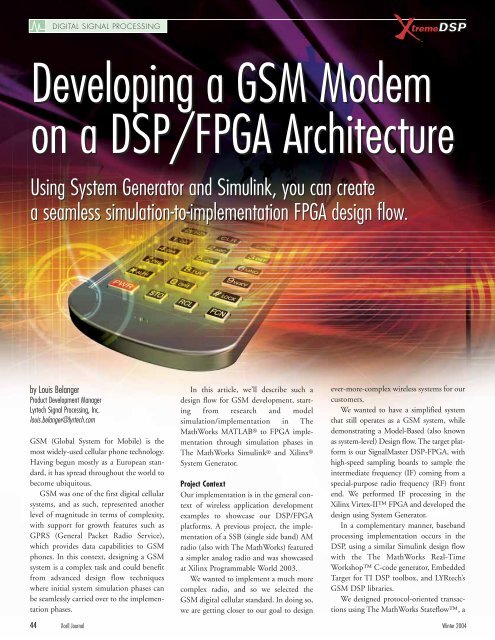Xcell Journal: The authoritative journal for programmable ... - Xilinx
Xcell Journal: The authoritative journal for programmable ... - Xilinx
Xcell Journal: The authoritative journal for programmable ... - Xilinx
Create successful ePaper yourself
Turn your PDF publications into a flip-book with our unique Google optimized e-Paper software.
DIGITAL SIGNAL PROCESSING<br />
Developing a GSM Modem<br />
on a DSP/FPGA Architecture<br />
Using System Generator and Simulink, you can create<br />
a seamless simulation-to-implementation FPGA design flow.<br />
by Louis Belanger<br />
Product Development Manager<br />
Lyrtech Signal Processing, Inc.<br />
louis.belanger@lyrtech.com<br />
GSM (Global System <strong>for</strong> Mobile) is the<br />
most widely-used cellular phone technology.<br />
Having begun mostly as a European standard,<br />
it has spread throughout the world to<br />
become ubiquitous.<br />
GSM was one of the first digital cellular<br />
systems, and as such, represented another<br />
level of magnitude in terms of complexity,<br />
with support <strong>for</strong> growth features such as<br />
GPRS (General Packet Radio Service),<br />
which provides data capabilities to GSM<br />
phones. In this context, designing a GSM<br />
system is a complex task and could benefit<br />
from advanced design flow techniques<br />
where initial system simulation phases can<br />
be seamlessly carried over to the implementation<br />
phases.<br />
In this article, we’ll describe such a<br />
design flow <strong>for</strong> GSM development, starting<br />
from research and model<br />
simulation/implementation in <strong>The</strong><br />
MathWorks MATLAB ® to FPGA implementation<br />
through simulation phases in<br />
<strong>The</strong> MathWorks Simulink® and <strong>Xilinx</strong> ®<br />
System Generator.<br />
Project Context<br />
Our implementation is in the general context<br />
of wireless application development<br />
examples to showcase our DSP/FPGA<br />
plat<strong>for</strong>ms. A previous project, the implementation<br />
of a SSB (single side band) AM<br />
radio (also with <strong>The</strong> MathWorks) featured<br />
a simpler analog radio and was showcased<br />
at <strong>Xilinx</strong> Programmable World 2003.<br />
We wanted to implement a much more<br />
complex radio, and so we selected the<br />
GSM digital cellular standard. In doing so,<br />
we are getting closer to our goal to design<br />
ever-more-complex wireless systems <strong>for</strong> our<br />
customers.<br />
We wanted to have a simplified system<br />
that still operates as a GSM system, while<br />
demonstrating a Model-Based (also known<br />
as system-level) Design flow. <strong>The</strong> target plat<strong>for</strong>m<br />
is our SignalMaster DSP-FPGA, with<br />
high-speed sampling boards to sample the<br />
intermediate frequency (IF) coming from a<br />
special-purpose radio frequency (RF) front<br />
end. We per<strong>for</strong>med IF processing in the<br />
<strong>Xilinx</strong> Virtex-II FPGA and developed the<br />
design using System Generator.<br />
In a complementary manner, baseband<br />
processing implementation occurs in the<br />
DSP, using a similar Simulink design flow<br />
with the <strong>The</strong> MathWorks Real-Time<br />
Workshop C-code generator, Embedded<br />
Target <strong>for</strong> TI DSP toolbox, and LYRtech’s<br />
GSM DSP libraries.<br />
We designed protocol-oriented transactions<br />
using <strong>The</strong> MathWorks Stateflow, a<br />
44 <strong>Xcell</strong> <strong>Journal</strong> Winter 2004

















